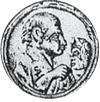Új és új hősöket. Az 1957-es Ady-ünnepség mint emlékezeti hely
Cuvinte cheie:
hero cult, Tîrgu MureșRezumat
The 1957 Celebration of Poet Endre Ady as a Lieu de Mémoire
In this dissertation, I examine the process of cult creation in the context of the nationwide celebrations of Hungarian poet Endre Ady organized in Romania in the 1950s. More broadly, I research how the post-war state-socialist power introduced its hero types in literature and theatre, thereby creating its own places of remembrance. Examining the ‘lieu de mémoire’ used in the sense rendered by Pierre Nora, it seems important that the new places of remembrance created by the power - museums, statues, heroes, oeuvres, literary evenings of theatres, etc. – create a sense of continuity, but in reality, they convey a radically new message, and try to achieve this mainly through a hero placed at the centre of the cult. In the retelling and activating of history (and the story), the disappearing difference between the ‘real’ and ‘would-be’ gives birth to a compulsion to repeat, which after a while leads to the emptying of the contents and the formation of double speech.
Referințe
KÖNYVÉSZET
ASSMANN, Jan, 2004, A kulturális emlékezet. Budapest, Atlantisz.
BOTTONI, Stefano, 2008, Sztálin a székelyeknél. Csíkszereda, Pro-Print.
DÁVIDHÁZI Péter, 2000, Irodalomtörténet és ünnepi beszéd, in Kalla Zsuzsa (szerk.), Az irodalom ünnepei. Kultusztörténeti tanulmányok. Budapest, PIM, 137–141.
GYÁNI Gábor, 2009, Relatív történelem. Budapest, Typotex.
KERESZTESNÉ VÁRHELYI Ilona, 2000, Egy kultusz metamorfózisai. A kultuszképződés modellje a debreceni Csokonai-kultusz fejlődésében, in Kalla Zsuzsa (szerk.), Az irodalom ünnepei. Kultusztörténeti tanulmányok, Budapest, PIM, 190.
KUNT Gergely, 2008, Bélyegek a propaganda és a kultuszteremtés szolgálatában (1914–1956). Elérhető: https://www.academia.edu/8585849/B%C3%A9lyegek_a_propaganda_%C3%A9s_a_kultuszteremt%C3%A9s_szolg%C3%A1lat%C3%A1ban_1914_1956_ (utolsó letöltés: 2019. május 1.)
LAKNER Lajos, 2000, Irodalmi kultusz, identitás, legitimáció, in Kalla Zsuzsa (szerk.), Az irodalom ünnepei. Kultusztörténeti tanulmányok. Budapest, PIM, 148–172.
NORA, Pierre, 1999, Emlékezet és történelem között. A helyek problematikája, Aetas, 3.
PÓTÓ János, 1986, Történelemszemlélet és politika. Budapest köztéri szobrai 1945 után. Történelmi Szemle, 3-4. 518.
SEBALD, W. G., 2014, Légi háború és irodalom. A rombolás természetrajza. Budapest, Európa.
SIEGMUND, Gerald, 1999, A színház mint emlékezet, Theatron, tavasz, 39.
Források
Ady-emlékest Marosvásárhelyen. Vörös Zászló, 1957. november 30., 6.
A kultúrotthonok művészi agitációs brigádjainak ajánljuk, Vörös Zászló, 1957. augusztus 12, 6.
ARANYOSSI Magda, 2018, Én régi, elsüllyedt világom. Nádas Péter széljegyzeteivel. Budapest, Jelenkor.
A Sepsiszentgyörgyi Állami Magyar Színház levele, 1954. 06. 16., Látó archívuma.
DERSI Tamás, 1957a, Ma leplezik le Ady Endre mellszobrát Nagyváradon. Esti Hírlap, november 24, 10.
DERSI Tamás, 1957b, Ady nyomában Adyfalván. Látogatás Ady szülőházában. Esti Hírlap, november 29., 11.
Igaz Szó, 1957, november, Ady-szám.
FÖLDES László, 1954, A jövőt formáló nép: irodalmunk pozitív hőse 2., Igaz Szó, november, 50–63.
Descărcări
Publicat
Cum cităm
Număr
Secțiune
Licență

Această lucrare este licențiată în temeiul Creative Commons Attribution 4.0 International License.
CC-BY permite reproducerea, distribuirea, arhivarea și citarea sa cu condiția să menționați autorii. Este obligatorie referința completă către articol care se găsește în rubrica Exemple de citare de pe această pagină. Dacă e posibil, vă rugăm adăugați și link-ul către acest site. Drepturile de copyright aparțin autorilor.




